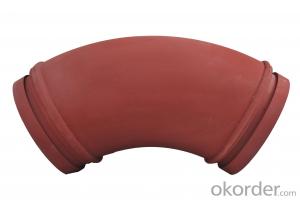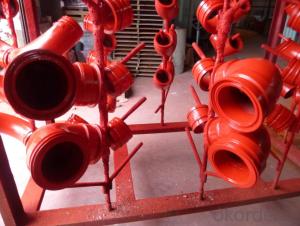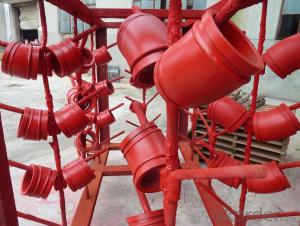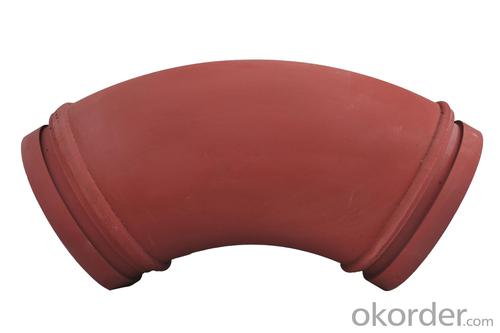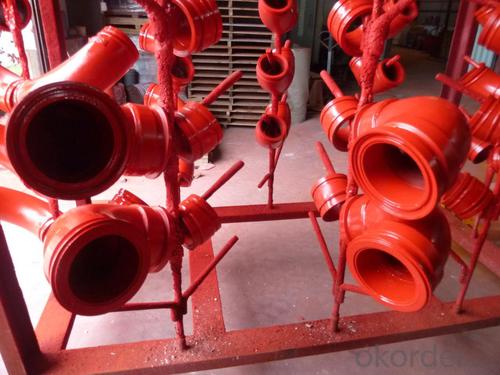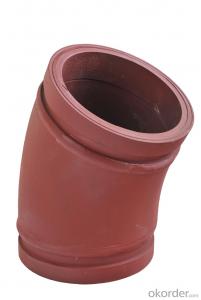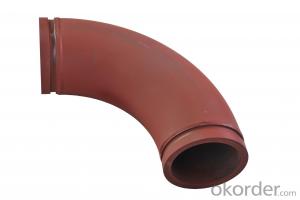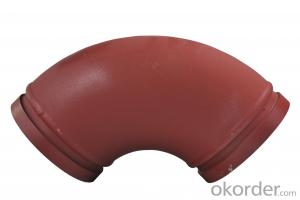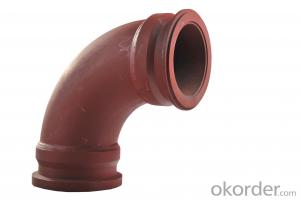Twin Wall Elbow for Concrete Pump R232 60DGR
- Loading Port:
- Tianjin
- Payment Terms:
- TT OR LC
- Min Order Qty:
- 10 pc
- Supply Capability:
- 3000 pc/month
OKorder Service Pledge
OKorder Financial Service
You Might Also Like
Twin Wall Elbow (Twin Wall Flange)
(1) Material: Q235 (outside) + GCr15(inside)
(2) Thickness: 3mm (outside) + 9mm (inside)
(3) Technology: Quenching under high temperature
(4) Characteristics: the inner rigidity to 63 HRC; the outside has so high toughness to keep the inner.
(5) Matched with: Twin wall flange, Alloy (GCr15) + 20#
(6) Working Pressure:170bar
(7) Service life: above 60,000 cubic meters.
(8) Package: PP woven bag and plastic cap
Twin wall elbow is created with research of us and need of the market. Its service life and working pressure are better than the casting. Besides, We can supply 90D, 45D, 30D, 25D, 20D, 15D, 10D. And it can be used for PM, JUNJIN, Schwing, Cifa, Sany, ect.
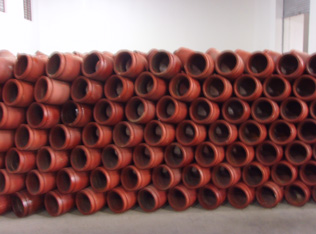
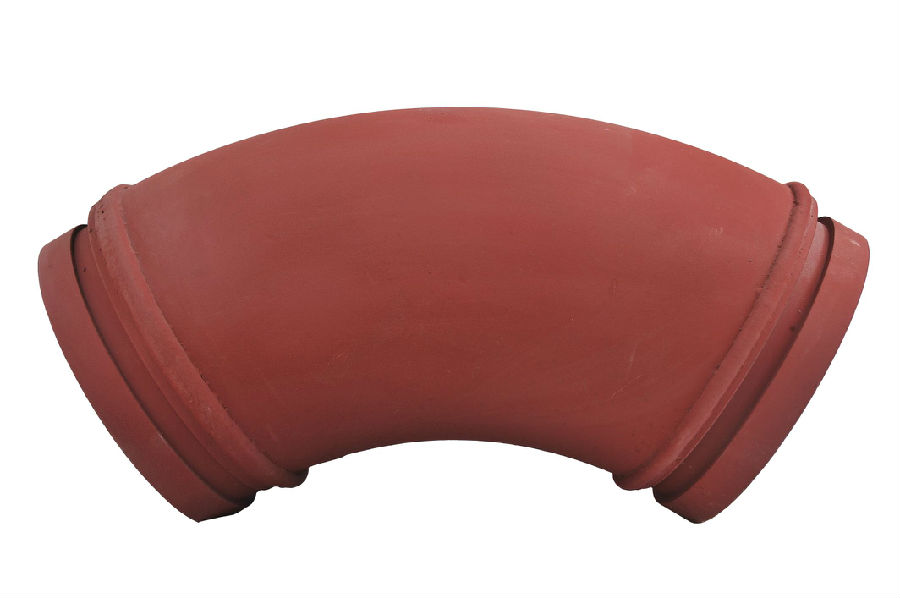
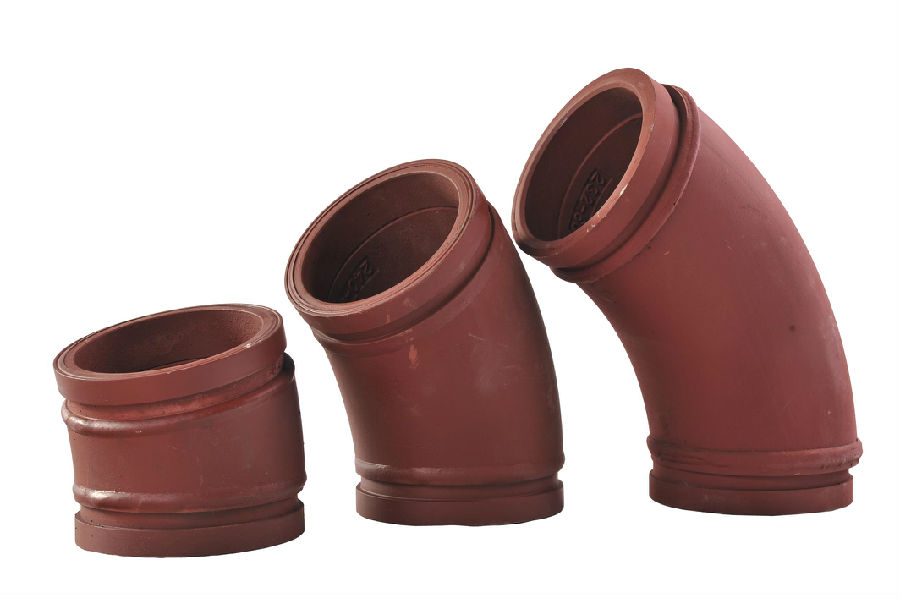
- Q: Are there any maintenance tips to extend the lifespan of concrete pump spare parts?
- Yes, there are several maintenance tips that can help extend the lifespan of concrete pump spare parts. 1. Regular Cleaning: It is important to regularly clean the spare parts to remove any dirt, debris, or concrete buildup. This can be done using a brush, water, and mild detergent. Cleaning helps prevent corrosion and ensures smooth operation. 2. Lubrication: Proper lubrication of moving parts is crucial to reduce friction and wear. It is important to follow the manufacturer's recommendations for lubrication intervals and use high-quality lubricants. Regularly inspect the lubrication points and replace any worn-out or damaged lubrication components. 3. Inspections and Maintenance: Regular inspections of all spare parts are necessary to identify any signs of wear, damage, or misalignment. Any issues should be repaired or replaced promptly. Additionally, following the maintenance schedule provided by the manufacturer is essential to address any potential problems before they escalate. 4. Proper Storage: When not in use, spare parts should be stored in a clean and dry environment to prevent rust and corrosion. They should be protected from extreme temperatures, moisture, and direct sunlight. Additionally, spare parts should be stored in a way that prevents any damage or deformation. 5. Correct Usage: It is crucial to operate the concrete pump in accordance with the manufacturer's guidelines. Overloading, excessive pressure, or improper operation can lead to premature wear and damage to the spare parts. Proper training should be provided to the operators to ensure they understand the correct usage techniques. 6. Regular Maintenance of the Concrete Pump: The overall condition of the concrete pump can have an impact on the lifespan of the spare parts. Regular maintenance of the pump, including cleaning, lubrication, and inspections, can help identify and address any potential issues that may affect the spare parts. By following these maintenance tips, the lifespan of concrete pump spare parts can be extended, reducing the need for frequent replacements and saving costs in the long run.
- Q: How does a hydraulic accumulator improve the performance of a concrete pump?
- A hydraulic accumulator improves the performance of a concrete pump by ensuring a constant and reliable flow of concrete. The primary function of a hydraulic accumulator is to store hydraulic energy in the form of fluid under pressure. In the case of a concrete pump, this accumulator stores energy from the hydraulic system and releases it when needed to assist in the pumping process. Concrete pumps require a consistent flow of concrete to maintain efficiency and productivity. However, the process of pumping concrete can be challenging, especially when dealing with variations in demand or pressure fluctuations. This is where a hydraulic accumulator comes into play. By storing excess hydraulic energy, the accumulator acts as a buffer, smoothing out any inconsistencies in the hydraulic system. When the pump requires an extra surge of power, the accumulator releases the stored energy, providing an additional boost to the hydraulic system. This ensures a continuous and steady flow of concrete, even during peak demand or pressure changes. Moreover, hydraulic accumulators also help in reducing the wear and tear on the pump components. By absorbing and dampening pressure shocks, they prevent sudden pressure spikes and fluctuations from reaching the pump. This helps to prolong the lifespan of the pump and minimize the risk of breakdowns or damage. Overall, a hydraulic accumulator plays a crucial role in improving the performance of a concrete pump by providing a steady flow of concrete, reducing pressure fluctuations, and protecting the pump from excessive wear and tear. It enhances the efficiency, reliability, and durability of the pump, ultimately leading to increased productivity and cost savings in concrete pumping operations.
- Q: What are the specifications for concrete delivery pumps?
- Towed concrete pumps can be towed or towed by motor vehicles, but they are not allowed to carry any goods. The speed of towing shall not exceed 8km/h;
- Q: What is the role of a concrete pump hopper agitator blade?
- The role of a concrete pump hopper agitator blade is to mix and agitate the concrete mixture in the hopper, ensuring a consistent and homogeneous mixture. This helps to prevent the concrete from settling or becoming too thick, allowing for a smoother and more efficient pumping process.
- Q: How often should the concrete pump wear plate be replaced?
- The frequency of replacing the concrete pump wear plate depends on several factors such as the type of concrete being pumped, the volume of concrete being pumped, and the operating conditions of the pump. Generally, wear plates are designed to withstand a certain amount of wear and tear before requiring replacement. In most cases, it is recommended to inspect the wear plate regularly to check for signs of excessive wear. This can include visible cracks, erosion, or a significant decrease in thickness. Regular visual inspections can help determine when it is time to replace the wear plate. Additionally, monitoring the pump's performance and efficiency can also provide insights into the wear and tear on the wear plate. If there is noticeable decrease in the pump's output or an increase in the required pumping pressure, it may indicate that the wear plate needs to be replaced. However, it is important to consult the manufacturer's guidelines and recommendations for your specific concrete pump model. They often provide recommendations on the expected lifespan of the wear plate and the intervals at which it should be replaced. Following these guidelines can help ensure optimal performance and longevity of your concrete pump.
- Q: How often should hopper grate springs be inspected or replaced in a concrete pump?
- Hopper grate springs in a concrete pump should be inspected regularly to ensure optimal performance and prevent any potential issues. The frequency of inspection or replacement depends on several factors such as the pump's usage, operating conditions, and the manufacturer's recommendations. However, a general guideline is to inspect the hopper grate springs at least once every six months or after every 500 hours of operation, whichever comes first. During the inspection, it is important to thoroughly examine the springs for any signs of wear, damage, or deformation. Look for cracks, excessive rust, or loss of tension in the springs. If any of these issues are detected, immediate replacement is necessary to maintain the proper functioning of the hopper grate system. Regular inspection and timely replacement of hopper grate springs are crucial to prevent clogging or blockage in the hopper, which could lead to pump malfunctions or downtime. It is advisable to consult the concrete pump manufacturer's guidelines or seek assistance from a professional technician to determine the specific inspection and replacement intervals based on the pump's make and model.
- Q: How to deal with the blockage in the outlet of the distributing valve of the concrete pump?
- If this method does not dare, it can only be manually removed, remove the connecting pipe, remove the debris in the valve.
- Q: How can one determine the correct size and dimensions of concrete pump spare parts?
- To determine the correct size and dimensions of concrete pump spare parts, there are several important steps to follow: 1. Identify the specific make and model of your concrete pump: Each concrete pump has its own unique specifications and requirements for spare parts. Therefore, it is crucial to know the make and model of your pump before ordering any spare parts. 2. Consult the manufacturer's documentation: Manufacturers often provide detailed documentation that includes information on the required size and dimensions of spare parts. This documentation may include technical drawings, diagrams, and part numbers that can help you find the correct size. 3. Measure the existing spare part: If you already have a spare part that needs replacement, you can measure its size and dimensions using precision tools like calipers or a measuring tape. Take accurate measurements of key dimensions such as length, width, height, and any other relevant specifications. 4. Seek professional assistance: If you are unsure about the correct size and dimensions, it is advisable to consult with a professional or an authorized dealer. They have expertise in concrete pumps and can guide you in selecting the right spare parts based on your pump's specifications. 5. Consider compatibility and quality: When purchasing spare parts, ensure they are compatible with your concrete pump's make and model. Additionally, prioritize quality to ensure longevity and optimal performance. Buying from reputable suppliers or directly from the manufacturer can help ensure the spare parts meet the necessary size, dimensions, and quality standards. By following these steps, you can accurately determine the correct size and dimensions of concrete pump spare parts, ensuring smooth operation and minimizing downtime.
- Q: What are the different types of concrete pump rubber hoses?
- In the market, you can find a variety of concrete pump rubber hoses. These hoses come in different types to cater to specific needs. The first type is the Steel Wire Reinforced Hose, which is the most commonly used. It is built with multiple layers of steel wire to provide maximum strength and durability. This type of hose is suitable for high-pressure applications and can handle the heavy pumping of concrete effortlessly. Another type is the Textile Reinforced Hose, which is reinforced with multiple layers of textile fabric like nylon or polyester. These hoses are lighter in weight compared to the steel wire reinforced ones, making them easier to handle and maneuver. They are suitable for medium-pressure applications and are commonly used in smaller concrete pumps. Then there is the Fabric Hose, which is made from a single layer of fabric like nylon or polyester. These hoses are lightweight and flexible, making them easy to handle and transport. Fabric hoses are suitable for low-pressure applications and are commonly used in small-scale construction projects. Composite Hoses are made from a combination of different materials such as rubber and plastic. These hoses are lightweight and highly flexible, which makes them ideal for applications where maneuverability is crucial. They are commonly used in smaller concrete pumps and can handle both low and medium pressure. Lastly, there are Flanged Hoses, which have flanges attached at both ends. These flanges are used to connect the hose to the pump and the nozzle, providing a secure connection and preventing any leaks or disconnections during the pumping process. Flanged hoses are commonly used in high-pressure applications and are suitable for large-scale construction projects. In conclusion, the choice of concrete pump rubber hose depends on specific project requirements. Factors such as pressure, size, and type of concrete being pumped should be considered to ensure efficient and safe concrete pumping operations.
- Q: Are there any specific safety precautions for handling concrete pump spare parts?
- Yes, there are specific safety precautions that should be followed when handling concrete pump spare parts. Firstly, it is important to wear appropriate personal protective equipment (PPE) such as gloves, safety goggles, and a dust mask to protect against any potential hazards. Concrete dust can be harmful if inhaled or comes into contact with the skin, so it is important to take necessary precautions. When handling concrete pump spare parts, it is crucial to ensure proper lifting techniques are used to avoid strains or injuries. Heavy parts should be lifted with the help of lifting equipment or with the assistance of others to minimize the risk of accidents. Additionally, it is important to handle the spare parts with care and avoid any rough handling or dropping, as this can lead to damage or breakage. Damaged spare parts can affect the overall performance and safety of the concrete pump. Furthermore, it is recommended to store the spare parts in a clean and dry area, away from any moisture or chemicals that could potentially damage them. Proper storage will help maintain the quality and integrity of the spare parts. Lastly, it is always advised to follow the manufacturer's instructions and guidelines when handling concrete pump spare parts. They often provide specific safety precautions and recommendations that should be followed to ensure the safe handling and use of the parts. By following these safety precautions, the risk of accidents, injuries, and damage to the concrete pump spare parts can be minimized, ensuring a safe working environment.
Send your message to us
Twin Wall Elbow for Concrete Pump R232 60DGR
- Loading Port:
- Tianjin
- Payment Terms:
- TT OR LC
- Min Order Qty:
- 10 pc
- Supply Capability:
- 3000 pc/month
OKorder Service Pledge
OKorder Financial Service
Similar products
Hot products
Hot Searches
Related keywords
